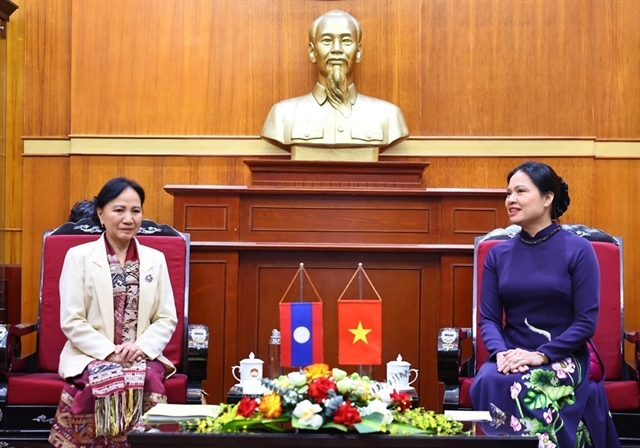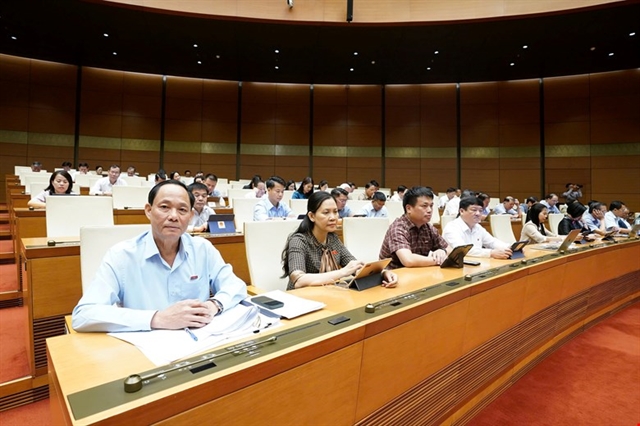 Politics & Law
Politics & Law

 |
| National Assembly deputies at the meeting. — Photo quochoi.vn |
HÀ NỘI — Legislators on Tuesday reviewed a draft Law on Science, Technology and Innovation, with proposals aimed at cutting red tape, promoting private sector engagement and creating a legal framework to drive national development through research and innovation.
As part of the ongoing 9th session of the 15th National Assembly (NA), and chaired by Deputy Chairman of the NA Lê Minh Hoan, lawmakers heard a Government proposal and a verification report on the draft legislation, which introduces sweeping updates to the existing 2013 Law on Science and Technology.
On behalf of the Government, Deputy Prime Minister Lê Thành Long said the proposed law responded to more than a decade of evolving needs. While the 2013 legislation laid a solid legal foundation, many of its provisions had become outdated in light of current demands for scientific advancement and socio-economic growth.
The draft law consists of eight chapters and 83 articles - two more than the current version - and incorporates the concept of innovation throughout its structure. It sets out mechanisms to support scientific research, encourage technology development, and promote innovation as key pillars of national competitiveness, sustainable development, and improved living standards.
It applies to both domestic and foreign organisations and individuals engaged in science, technology and innovation activities in Việt Nam, or abroad, where governed by Vietnamese law or international treaties to which Việt Nam is a party.
Deputy PM Long noted that the draft was aligned with key policies outlined in the Government resolution, including reforms in research management, development of scientific capacity, investment mobilisation, business incentives, public knowledge dissemination, and support for start-ups.
A key principle underpinning the draft is administrative simplification, according to Long. It proposes a shift from procedural control to outcome-based management, backed by comprehensive digital transformation in both governance and scientific activities. The law also seeks to attract private funding through new incentives for enterprise investment in research and innovation.
Presenting the verification report, chairman of the NA’s Committee on Science, Technology and Environment, Lê Quang Huy, voiced strong support for the draft. He urged greater emphasis on the role of businesses, particularly private enterprises, as drivers of innovation.
He called for more decentralisation, simplified procedures, and breakthrough policies that not only support scientific advancement but also enable agile and appropriate State management.
The committee endorsed the provision to accept a certain level of risk in scientific and innovation activities, but recommended safeguards to distinguish between acceptable risks and ethical or procedural violations. It supported the introduction of controlled testing mechanisms and revenue-sharing models for commercialised research funded by the State.
However, it suggested clearer guidelines for profit-sharing ratios and encouraged flexibility through negotiated contracts.
Regarding enterprise participation, the committee reaffirmed that businesses serve as a crucial force in Việt Nam’s innovation ecosystem, providing both financial and human resources for research and development (R&D) and introducing new products and technologies to the market. It recommended to ensure consistency between this law and other regulations governing investment, finance, infrastructure, and human capital.
Some members suggested reviewing the classification of 'academies' under the law and called for new provisions to support interdisciplinary research centres that integrate social sciences with natural sciences and engineering. The committee also asked for legal clarity on the role of higher education institutions as scientific entities, to avoid overlaps with other affiliated organisations.
On human resources, the committee proposed policies to support advanced training, international collaboration, and mobility for scientists across universities, research institutes, and businesses. It also suggested criteria for recognising experts and talented individuals, along with regulations to ensure autonomy in recruitment, research and finance.
Additional recommendations included support for STEM and STEAM education programmes, and policies to foster a national culture of innovation.
Regarding funding, the committee advised the Government to streamline regulations to attract private and community investment, consolidate scientific funding mechanisms, and enhance cooperation between central and local-level science and technology funds. It also called for simplified procedures for funding strategic infrastructure projects in science, technology and innovation. — VNS